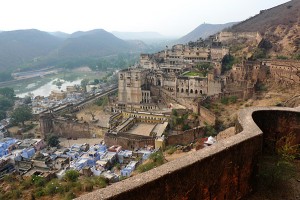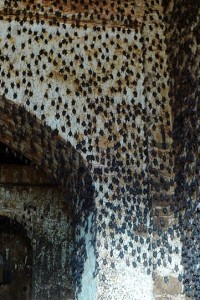Into the Bat Palace
 Be it in India or elsewhere, it is fascinating to see forts and palaces that once represented the pinnacle of wealth, technological achievement and regional pride reduced to crumbling ruins, mere curiosities for visitors, ignored by the locals, and slowly overtaken and reclaimed by nature.
Be it in India or elsewhere, it is fascinating to see forts and palaces that once represented the pinnacle of wealth, technological achievement and regional pride reduced to crumbling ruins, mere curiosities for visitors, ignored by the locals, and slowly overtaken and reclaimed by nature.
India’s large western province of Rajasthan is home to innumerable such sights. Always independently spirited, in the “Wild West” of India it seems you can’t go anywhere without stumbling upon an even more impressive medieval fortification, old palace or simply scores of lavish, beautifully decorated mansions. Of all of these, some are still lived in, some have become museums, and some have been left to slowly wither away and decay unattended.
While neither the most well known nor the most impressive of the region, the Bundi Palace in (surprise) the town of Bundi is nevertheless one of the most atmospheric.
It’s not actually a single palace, but an amalgamation of a number of smaller palaces built on top of and around each other, most within the 17th century. These include the Chhatra Mahal, Phool Mahal, Badal Mahal, Umed Mahal and Sheesh Mahal (this is how I learned that Mahal means palace).
This tortured growth of interconnected palaces, the massive fort of Taragarh on the hill above and fortified ramparts surrounding both, the labyrinth of secret tunnels criss-crossing through the hill under these, and the convoluted scenic and man-made artistic beauty of it all prompted Rudyard Kipling, who sojourned in the peaceful setting of Bundi to write Kim, to call it “the work of goblins rather than of men.”
Goblins or no, we thoroughly enjoyed it. Between the beautiful murals in some of the palaces, the open air gardens and pool magically overlooking the whole town, the maze of arches, passageways and pillars, and large wooden doors with metal spikes, the place felt indeed like one of those fairy tale palaces of old. Better yet, because Bundi isn’t a major stop on most tourist itineraries we virtually had the whole place to ourselves.
By late afternoon, we were clearing paths through the underbrush, and scaling several of the ramparts to try to gain access to hidden or blocked off sections of the palaces, earning a running commentary from the nearby monkeys not used to such encroachments into their territory.
In places, there were hives of wasps so huge they defied common sense. When the wasps number not in the thousands but in the tens of thousands, a loud, dark, ominous mass of buzzing, how do those in the middle survive? How do they stay attached to the intricately carved stone arches?
In another, we ventured inside to a black, cavernous chamber. Our eyes adjusting to the darkness, our footsteps light on the dirt floor, the strong smell of something familiar yet which I couldn’t quite place assaulted our nostrils. As our vision cleared and our ears processed the significance of the constant background of high-pitched screeching, we saw that we were surrounded by bats. Bats everywhere. Not just above us in a sea of black but also hanging down to eye level on all the walls in each direction, a mass of black, sightless, twitching creatures resting before their nocturnal escape.
How far the story of these palaces have come. Once the abodes of the mightiest rulers of the land and the luxurious lifestyle of their royally pampered families, now the dominion of troops of monkeys, throbbing hives of wasps, and sleeping quarters of the dreaded and reviled flying rats.

 Click to subscribe via RSS feed
Click to subscribe via RSS feed

Fascinating. A side of India I didn’t know existed, captured in just a few words. I wonder what it is about the West that it always becomes wild.. is there something in the setting sun that brings this about?
India has one of the oldest civilizations. How fascinating to stand in front of the ruins. The glory of the old palaces has gone, but its beauty remains. Looking at the picture (not the bat one), I can’t help imagining the past of the palaces and their stories …
I have so many comments, but they are all getting twisted together just like the ruins. I can’t figure out how to get them out. The only solution is to leave about twenty independent comments. However I don’t feel that ambitious.
P.S. I feel compelled to tell you I look forward to receiving your blog. Thanks for taking the time!!!!
This view of the Taragarh fortress on the hills with the wall in the foreground, the valley, and the surrounding mountains is truly magical!
Thanks! It’s very rewarding to be able to share this trip with friends and family, and enjoyable for me to “revisit” certain places through writing or pictures.
I thought they were bees, but either way you look around not seeing all that many flowers and wonder, just what supports them all! Crazy!
Yeah, I remember wondering the same thing. What in the world do they eat??
Fun running into you in Pushkar like that, Kerry. You back home?
Yep, I’m home. Yeah, that was cool, too bad we didn’t have time to have dinner or something. Glad to be back home. It’s neat to see, but that country really takes it out of ya! Towards the end, we went back to the Taj Mahal, and my friend finally got fed up at the guys trying to tell you where to take a picture for a tip. He started yelling at the dude to leave him alone and get away. The guy walked off mumbling something about Americans and Bush. I said, “Wait a minute, he’s Canadian!”. Now I’ve discovered why American tourists have such bad reps. It’s the Canadians’ fault!
lol. Not only that, but 80% of the good “Canadians” that everyone is so fond of are actually undercover Americans!